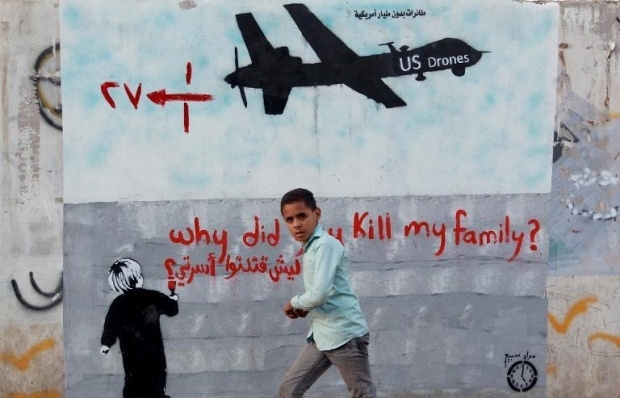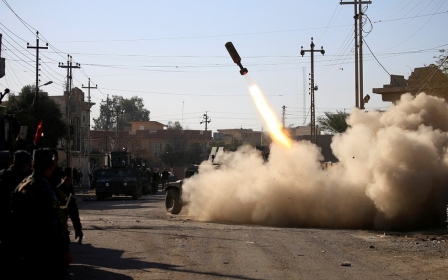Middle East drone wars heat up amid surge in armed UAV sales

The number of states deploying armed drones has quadrupled in the past five years and is set to double in the next two years, according to a new report.
At least seven Middle East states now operate indigenous armed drones or have launched strikes from armed drones imported from China.
Countries that currently operate drones include Iran, Turkey, Iraq, Saudi Arabia, UAE, Israel and Egypt.
The increase in drone usage also comes amid questions over the number of civilian casualties caused by drone strikes.
As recently as 2013 just three countries- the UK, US and Israel - operated armed drones, but the number of operators has soared as states, such as Turkey and Egypt, have deployed arms drones to monitor and strike militant groups, including the Kurdistan Workers' Party and Islamic State.
The report from Drones Wars UK, an Oxford-based pressure group, warned that the “so-called risk-free” strikes offered by drones had proved “attractive” in the Middle East and for “targeted killings”.
Drones Wars, however, also warned that there were “continuing about the number of civilian casualties caused by this type of warfare” and “whether the spread of armed drones will help or hinder the rule of law”.
Trump's drone surge
The main international agreement controlling the proliferation of drones, the Missile Technology Control Regime (MTCR), is coming under increasing pressure from the US defence industry and voices within the Trump administration
Last month, the US State Department loosened restrictions on the marketing and the sale of armed drones by US firms, after complaints that many of Washington’s allies and top defence customers were turning to Chinese or Russian made drones due to strict US export rules.
Chris Cole, director of Drone Wars UK, said the report should “serve as a wake-up call” that the proliferation of drone technology is “well underway”.
He said: “We urge the UK as well as other states to engage in multilateral discussions to control the proliferation of armed drones and to ensure that all states use this technology in accordance to international law.”
Iran, Turkey, Saudi Arabia, UAE have all launched drone strike beyond their borders, including Iran in Syria, and Turkey in Syria.
The UK and US have used armed drones extensively across the Middle East to carry out thousands of strikes, to the dismay of rights groups, including in Iraq, Syria, Libya and Yemen.
And, in recent days Israel's use of drones to deploy tear gas against Palestinian protesters has been the focus of international attention.
Smaller, cheaper but still lethal?
But, the report also warned that some non-state militant groups, including Islamic State, the PKK, Hezbollah, Hamas, Yemeni Houthis have also deployed weapons-carrying unmanned aircraft.
It found that Islamic State alone has carried out at least 121 strikes using armed drones, with the US military reporting up to 10 Islamic State drones a day spotted above Mosul during February 2017.
Hezbollah first made use of armed drones in 2006 to carry explosive into Israel but has also used them against Islamic State fighters in Syria, while Hamas has flown armed drones towards Israel on several occasions.
Nick Waters, a former British Army officer and drone researcher, told MEE: “Technology has reached a point where small commercial and hobby drones can be used in a manner similar to the way conventional forces have used drones for decades.”
He added they were “cost-effective key enablers” for armed groups, and that given the rapid spread of armed droned he would be “very surprised if we did not see drones being used by all sides in virtually all future conflicts”.
He cited the example of the Islamic State which used drones to watch enemy positions, and to direct troops and artillery in Iraq and Syria. The group paired drones with intelligence systems “to spectacular effect” to direct suicide bombers to hit their targets “at the right place and at the right time”, he added.
The Drone Wars UK report, which was released at an event in parliament on Wednesday, comes amid increasing calls from campaigners for increased international regulation of armed drones.
“There are currently discussions ongoing at the UN on drones, and it is imperative that countries agree on standards to contain the risks presented by these technologies and address the harm already caused,” Elizabeth Minor, an advisor to arms campaign group Article 36, told MEE.
Waters, focusing on smaller drones used by non-state forces, added: “Many of these drones effectively toys, yet can also be used as a very effective weapon of war.”
He added that drones should potentially be considered dual-use items and controlled in a similar way to other defence technologies, but warned that “considering how small and cheap these drones are, it will be very difficult, if not impossible, to control their proliferation into other conflict areas.”
Middle East Eye propose une couverture et une analyse indépendantes et incomparables du Moyen-Orient, de l’Afrique du Nord et d’autres régions du monde. Pour en savoir plus sur la reprise de ce contenu et les frais qui s’appliquent, veuillez remplir ce formulaire [en anglais]. Pour en savoir plus sur MEE, cliquez ici [en anglais].





